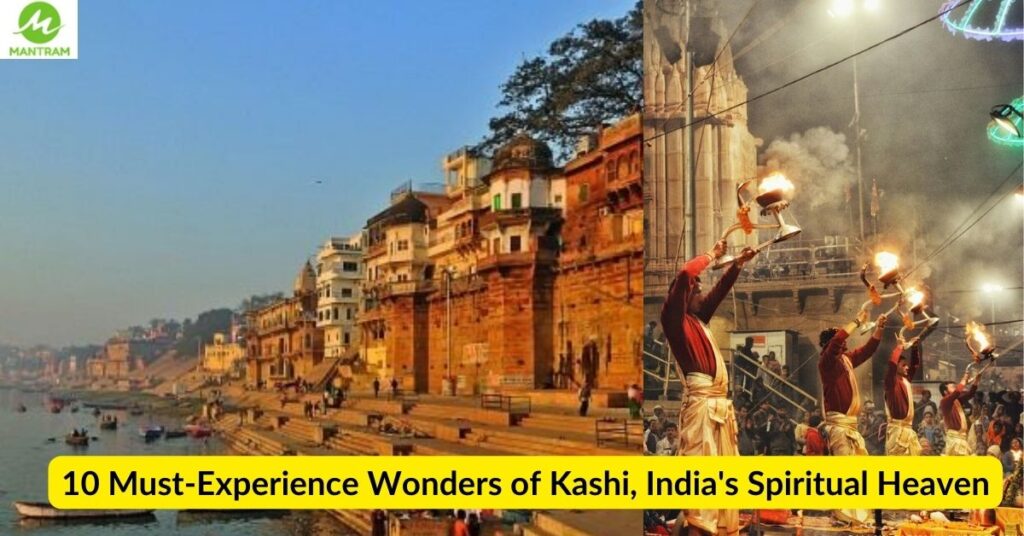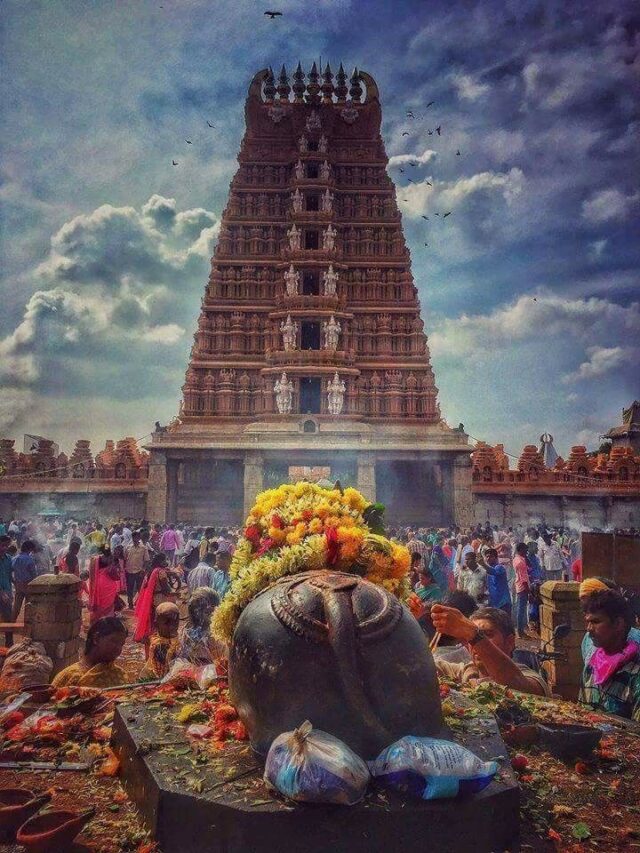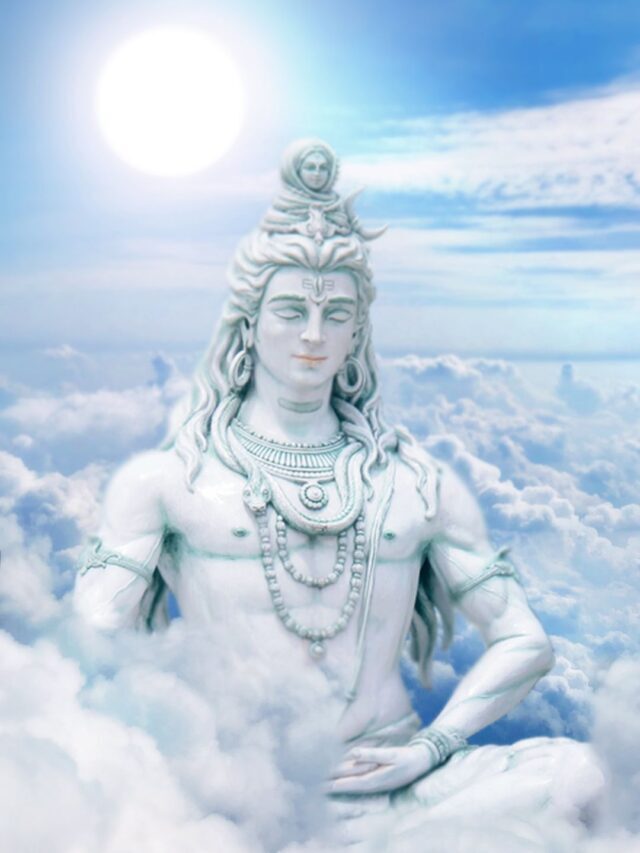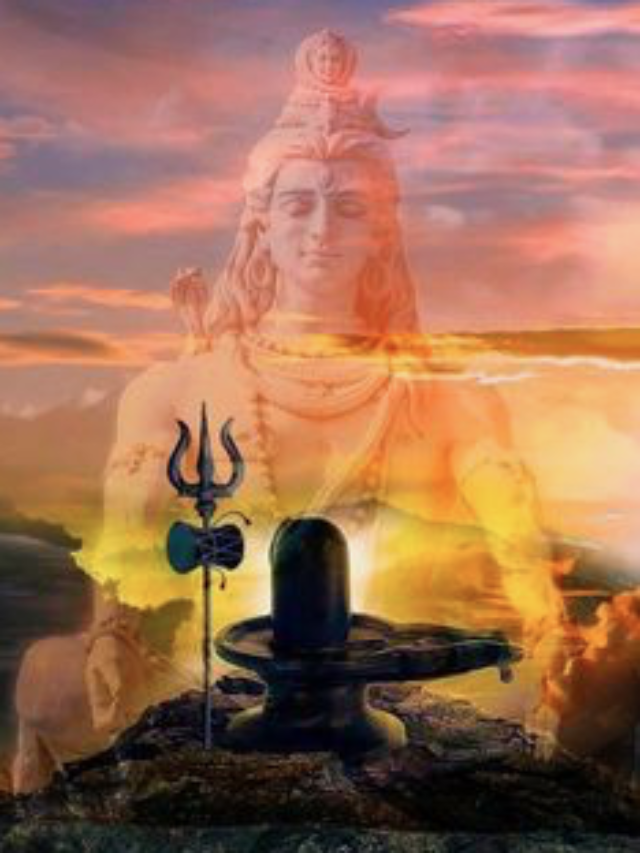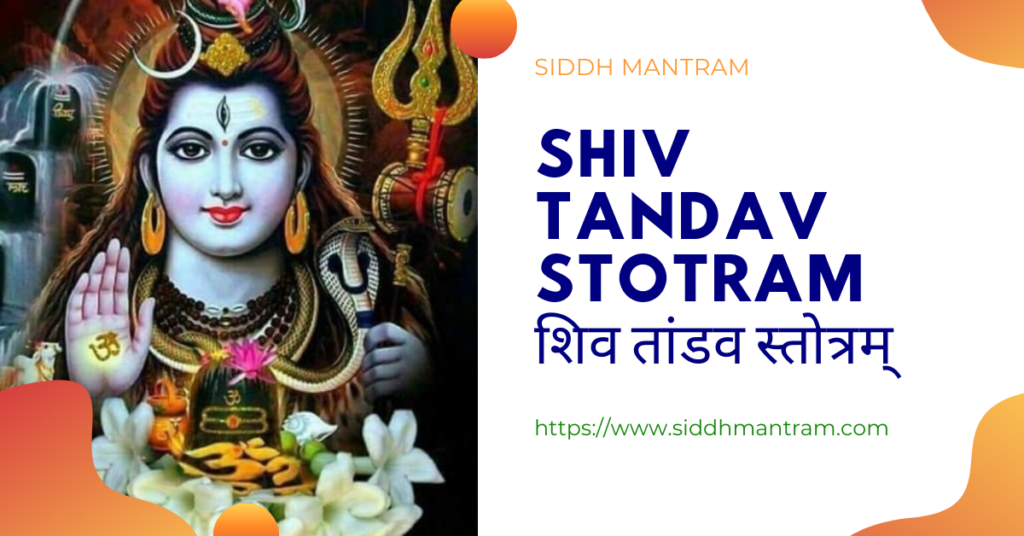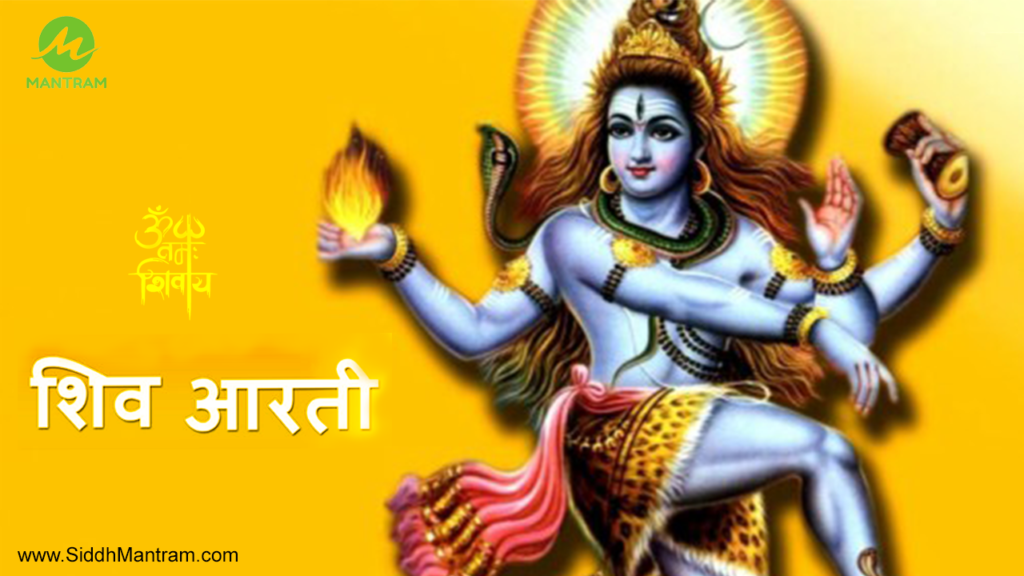Introduction:
Kashi, also known as Varanasi, is a place steeped in spirituality and rich in cultural heritage. Situated on the banks of the sacred Ganges River, this ancient city holds immense significance for millions of pilgrims and tourists.
Kashi is also considered a center of learning and knowledge. It has been a hub of education, philosophy, and arts for thousands of years. Many scholars and spiritual seekers have come to Kashi to deepen their understanding of the scriptures and gain spiritual insights. If you’re seeking a transformative and unforgettable experience, here are ten compelling reasons why you must visit Kashi at least once in your lifetime.
1.Spiritual Serenity:
Kashi is renowned as the spiritual heart of India. The city’s divine aura and the presence of numerous temples and ghats create a sense of serenity that touches the soul. Witnessing the Ganga Aarti at sunrise or sunset is a mesmerizing experience that will leave you feeling spiritually uplifted.
It is believed that the divine city of Kashi was created by Lord Shiva himself. The story of Kashi’s creation is narrated in the ancient Hindu scriptures:-(why was Kashi Created?)
Legend has it that after the creation of the universe, Lord Shiva and his consort Goddess Parvati were discussing the best place where Shiva could reside on Earth. During their discussion, Lord Shiva came up with the idea of creating a city where people could attain ultimate liberation (moksha) from the cycle of birth and death (samsara). He wanted a place that would be a confluence of spirituality, knowledge, and devotion.
Kashi Vishwanath Jyotirlinga:
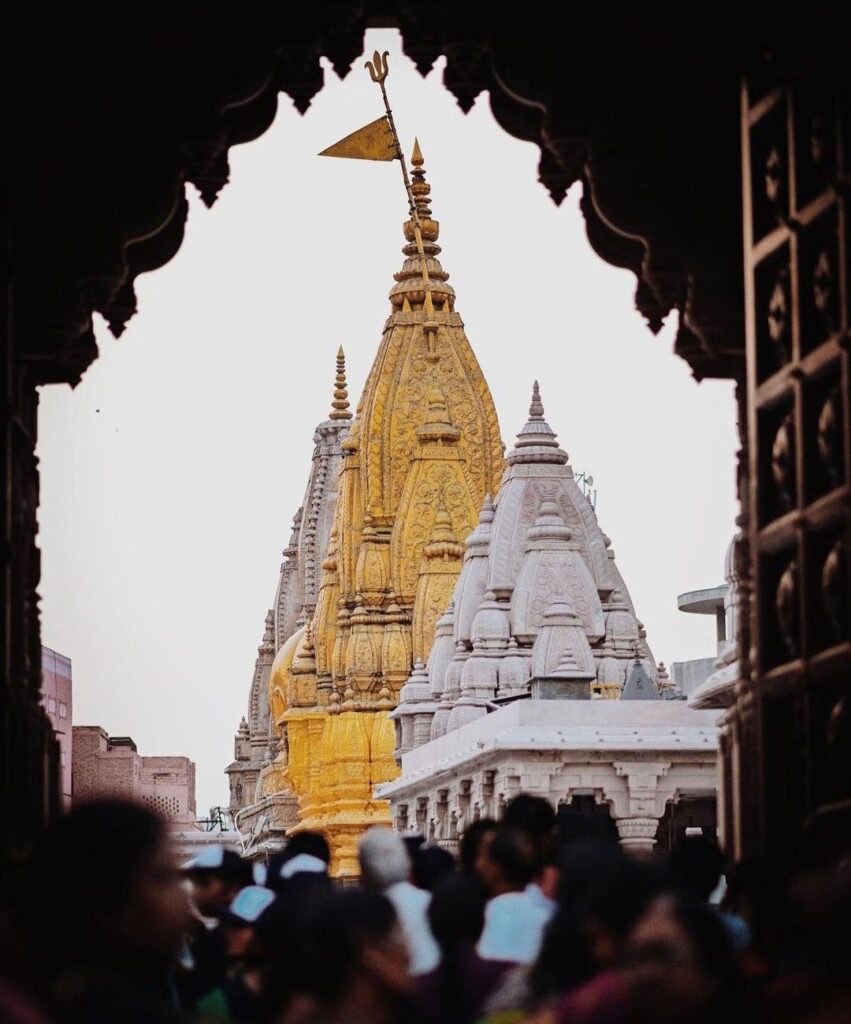

Lord Shiva chose the land where Kashi stands today to fulfill this divine purpose and created the city himself. He laid the foundations and sanctified it with his divine presence, making it a sacred place for people to seek spiritual enlightenment and liberation. This is why Kashi is often called “Shiva’s City” or “City of Lord Shiva.”
The Kashi Vishwanath Jyotirlinga:-As for how Lord Shiva lived at Kashi, it is believed that he has been residing there in the form of the immortal and invisible Jyotirlinga (a representation of the divine and infinite light) known as Vishwanath, which means “Lord of the Universe.” The Vishwanath Jyotirlinga is one of the twelve Jyotirlingas considered supremely sacred to Lord Shiva, and it symbolizes his infinite and eternal presence in Kashi.
During Sawan Month Kashi becomes more joyful and the celebration around the city one must experience at once.
About The Vishwanath Jyotirlinga Temple Story, Architecture and Importance:-
Kashi Vishwanath Temple, also known as the Golden Temple of Varanasi, is one of the most revered and significant temples in Hinduism. Here are the details about the temple:
Location of Vishwanath Jyotirlinga Temple
The Kashi Vishwanath Temple is situated in the city of Varanasi, also known as Kashi or Banaras, in the state of Uttar Pradesh, India. It is located along the western bank of the sacred River Ganges.
Architecture of Vishwanath Jyotirlinga Temple
The temple’s architecture showcases a blend of various styles due to its reconstruction over the centuries. The current structure is a result of extensive renovations during the 18th century. The main temple is known for its stunning golden spire, which is a major highlight and gives it the name “Golden Temple.” The sanctum sanctorum houses the Jyotirlinga of Lord Shiva, a representation of his cosmic light and energy.
Importance of Vishwanath Jyotirlinga Temple Hindu Dharma:
Kashi Vishwanath Temple holds immense significance in Hinduism. It is considered one of the twelve Jyotirlingas, which are believed to be the most sacred abodes of Lord Shiva. Devotees believe that a visit to this temple and the darshan (sacred glimpse) of the Jyotirlinga can grant spiritual blessings and liberation from the cycle of birth and death.
Interesting Facts About Kashi Vishwanath Jyotirlinga:
- The original Kashi Vishwanath Temple is said to have been destroyed and rebuilt several times due to various historical events and invasions.
- The temple complex is vast and includes smaller shrines dedicated to other deities, such as Goddess Parvati, Lord Ganesha, and others.
- Non-Hindus are not allowed to enter the inner sanctum of the temple, but they can visit the outer premises to experience its architectural beauty and spiritual ambiance.
- The daily rituals and ceremonies performed at the temple follow age-old traditions and attract devotees from all over the world.
Why Kashi is so Important in Hindu dharma
Kashi holds tremendous importance in a person’s life from a spiritual perspective. It is believed that anyone who dies in Kashi attains “moksha” or liberation from the cycle of birth and death. It is said that the divine city has the power to grant salvation to the departed souls and purify their karmas. Thus, many Hindus wish to spend their last days in Kashi or have their ashes immersed in the sacred Ganges river in Kashi, believing it will lead to spiritual emancipation.
Its significance lies in its association with Lord Shiva and the belief that dying or spending time in Kashi can lead to Moksha.
Certainly! Here are some other important temples in Varanasi (Kashi), besides the Kashi Vishwanath Jyotirlinga Temple:
1.Kashi Kalabhairav Temple: This temple is dedicated to Lord Kalabhairav, a fierce form of Lord Shiva. It is believed to be one of the significant sacred spots in Varanasi.
2.Mrityunjay Mahadev Temple: This temple is dedicated to Lord Shiva in his form as “Mrityunjay,” the conqueror of death. It is considered auspicious to visit this temple to seek protection and blessings.
3.Ratneshwar Mahadev Temple: Dedicated to Lord Shiva, this temple is believed to grant the fulfillment of wishes to devotees who offer prayers with devotion and sincerity.
4.Bharat Mata Temple: Unlike traditional temples, this unique temple is dedicated to Mother India (Bharat Mata) and features a large relief map of India carved in marble.
5.Kaal Bhairav Nath Temple (Bharonath Temple): This temple is dedicated to Lord Bhairav and is situated near the Vishwanath Temple. It is believed to be one of the oldest temples in Varanasi.
6.Nepali Mandir (Kathwala Temple): This temple was gifted to the city by the King of Nepal and is known for its beautiful woodwork and Nepali architectural style.
7.Vishalakshi Temple: Dedicated to Goddess Vishalakshi, an aspect of Goddess Parvati, this temple is a revered site for worship in Varanasi.
8.Kardameshwar Mahadev Temple: This ancient temple is dedicated to Lord Shiva and is located on the Kardmeshwar Ghat.
Why Kashi is also known as Varanasi and Banaras?
According to Hindu mythology, Kashi is called Varanasi because it is believed to be the place where the sacred rivers Varuna and Asi meet. It is also called Banaras due to the ancient forest called “Banar” that once existed in this region. Both names highlight the city’s sacredness and spiritual significance in Hindu culture.
3.Purifying Ganges:
The Ganges River flowing through Kashi is believed to possess purifying powers. Taking a dip in its holy waters and performing rituals at the ghats is an integral part of the spiritual journey for visitors. The cleansing experience offers a sense of renewal and peace.
Arrival of Ganga on Earth:
According to Hindu mythology, the descent of the Ganga River to Earth was made possible through the penance of King Bhagiratha. He performed rigorous meditation and prayers to Lord Brahma to bring the heavenly river to cleanse the ashes of his ancestors and liberate their souls. Pleased with his devotion, Brahma granted his request, and the holy Ganga descended from the heavens, flowing through Lord Shiva’s matted locks to reduce the impact of her force. This event is known as Ganga’s descent or “Ganga Avatara.”
Religious Importance:
Ganga is considered a divine river in Hinduism, and its waters are believed to be pure and purifying. Varanasi, being blessed with the presence of the Ganges, holds immense spiritual significance. It is believed that taking a dip in the sacred waters of the Ganga in Varanasi can cleanse one’s sins and purify the soul. People from all over India, and even abroad, come to Varanasi to perform “Ganga Snaan” (holy bath) as a part of their spiritual journey.
Ganga Snaan (Holy Bath):
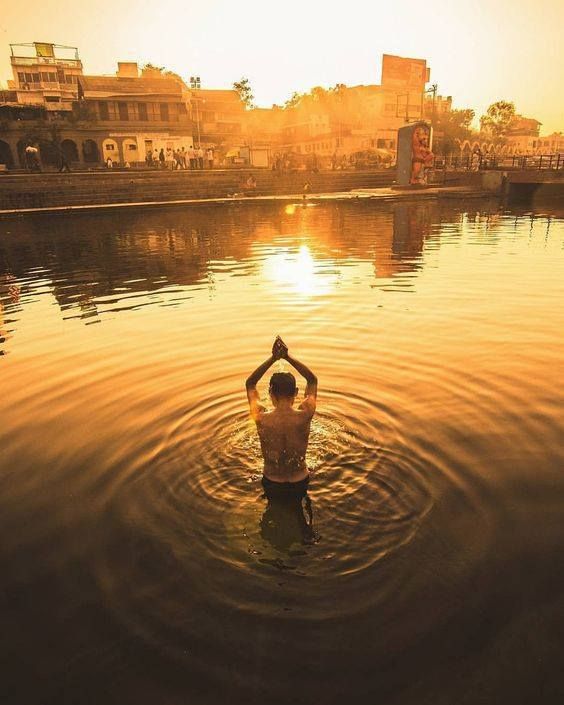

Ganga Snaan is a sacred ritual of bathing in the Ganges River. Devotees believe that immersing oneself in the holy waters can wash away sins, purify the mind, and bring spiritual blessings. It is common to see people performing Ganga Snaan at the ghats (steps leading to the river) of Varanasi, especially during auspicious occasions, religious festivals, and important dates in the Hindu calendar.
Ganga Aarti:
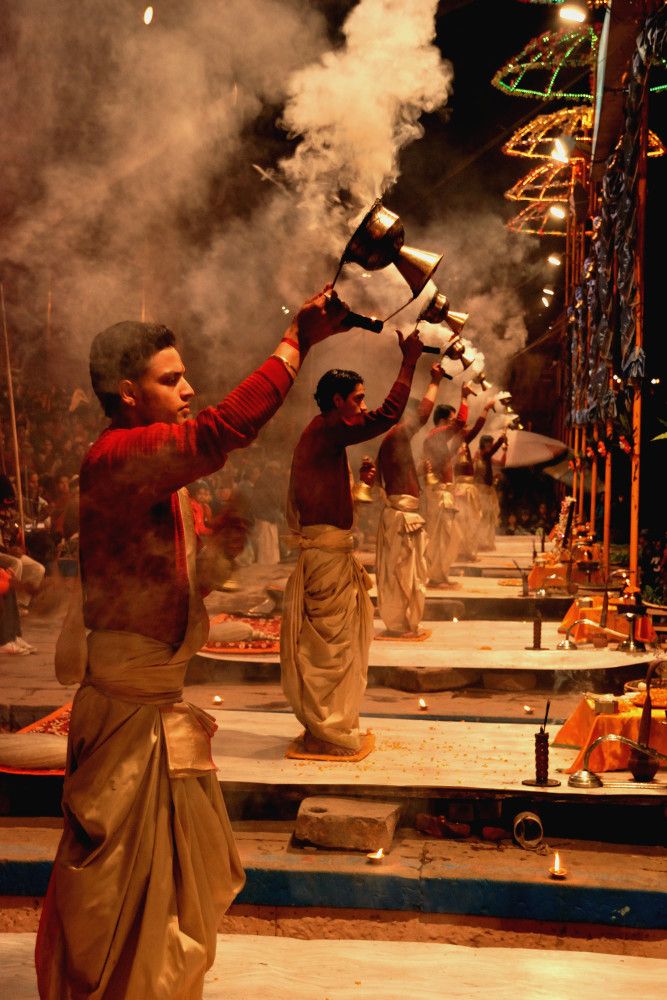

Ganga Aarti is a mesmerizing and deeply spiritual ritual performed every evening at the Dashashwamedh Ghat in Varanasi. The Aarti is a devotional offering to the River Ganga and is a sight to behold. Priests, holding large oil lamps adorned with flowers and incense, perform rhythmic movements accompanied by chanting of Vedic hymns and devotional songs. The Aarti is dedicated to Goddess Ganga, thanking her for the life-giving waters and seeking her blessings for the well-being of humanity. It is a significant attraction for tourists and devotees alike.
Significance of Ganga in Indian Culture:
The Ganges is not just a river in India; it is considered a divine mother and is venerated as “Ganga Ma.” The river is deeply intertwined with Indian culture, history, and spirituality. People often perform religious ceremonies, including “Pind Daan” (ritual offerings for ancestors), and immerse the ashes of the departed souls in the Ganges to facilitate their journey toward liberation.
Saptarishi Aarti Kashi
The “Saptrishi Aarti” at the Ganga Ghat in Varanasi is a unique and lesser-known ritual that is closely related to Lord Shiva in Hindu mythology. During this Aarti, the seven great sages or “Saptrishi” (Bhrigu, Atri, Angira, Marichi, Pulastya, Pulaha, and Kratu) are venerated and honored for their immense contributions to ancient Indian wisdom and spirituality.
The connection to Lord Shiva lies in the belief that these seven sages were not only great seers and sages but also the mind-born sons of Lord Brahma, the creator of the universe. Lord Shiva, being a part of the holy trinity in Hinduism, is the destroyer and the embodiment of the ultimate reality.
In the Saptrishi Aarti, devotees offer their prayers and gratitude to Lord Shiva and seek blessings from the Saptrishi for wisdom, knowledge, and spiritual guidance. The ritual emphasizes the close association between Lord Shiva, the Saptrishi, and the sacred Ganga river, as Varanasi is believed to be a city of immense spiritual significance for all these divine entities.
4.Age-Old Traditions:
Kashi is a cradle of ancient traditions and culture. The city’s rituals, music, and dance have been passed down through generations, making it a treasure trove of cultural heritage. Embrace the authenticity and immerse yourself in the traditional way of life.
Also Read- What is the story of Sawan Shivratri?
5.Ghats Galore:
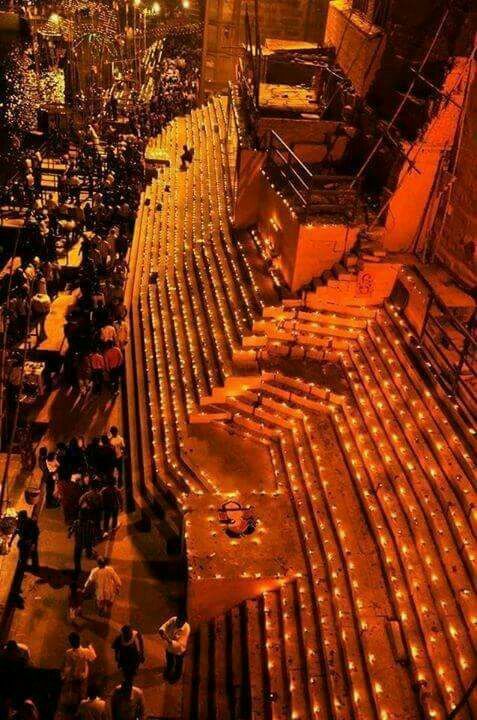

Kashi’s ghats hold a unique charm. Each ghat has its own story and significance, providing a glimpse into the city’s history and daily life. A boat ride along the river offers a unique perspective of the ghats and the bustling cityscape.
Here are some of the major ghats of Varanasi along with their basic details:
1.Dashashwamedh Ghat:
This is the most famous and central ghat in Varanasi. It is known for its grand Ganga Aarti (evening prayer ceremony) which attracts a large number of devotees and tourists. The ghat is associated with the legend of Lord Brahma’s ten-horse sacrifice (Dashashwamedh Yajna).
2.Manikarnika Ghat:
This is the main cremation ghat of Varanasi and is considered highly auspicious for Hindus to be cremated here. It is believed that cremation at Manikarnika Ghat ensures liberation from the cycle of birth and death.
3.Harishchandra Ghat:
Like Manikarnika Ghat, Harishchandra Ghat is another significant cremation ghat in Varanasi. It is named after the legendary king Harishchandra known for his unwavering truthfulness.
4.Assi Ghat:
Located at the confluence of the Ganges and the Assi River, this ghat is associated with the legendary sage Assi, who is said to have meditated here. It is a popular spot for pilgrims and tourists alike.
5.Kedar Ghat:
This ghat is known for its beautiful steps and a temple dedicated to Lord Kedar (Lord Shiva). It is believed that Lord Shiva resides here as Kedarnath.
6.Panchganga Ghat:
This ghat is believed to be the meeting point of five sacred rivers – the Ganges, Yamuna, Saraswati, Kirana, and Dhutapapa. It is considered highly purifying to take a dip at this ghat.
7.Scindia Ghat:
This ghat is adorned with a stunning Shiva temple and a sandstone palace built by the Scindia rulers of Gwalior.
8.Darbhanga Ghat:
Known for its beautiful Rajasthani architecture, Darbhanga Ghat is the largest and one of the most picturesque ghats in Varanasi.
9.Hanuman Ghat:
This ghat is dedicated to Lord Hanuman and has a prominent idol of the deity.
10.Lalita Ghat:
This ghat is named after the goddess Lalita, an aspect of Goddess Durga.
These are just a few of the many ghats that line the riverfront of Varanasi.
6.Majestic Sunrises and Sunsets:
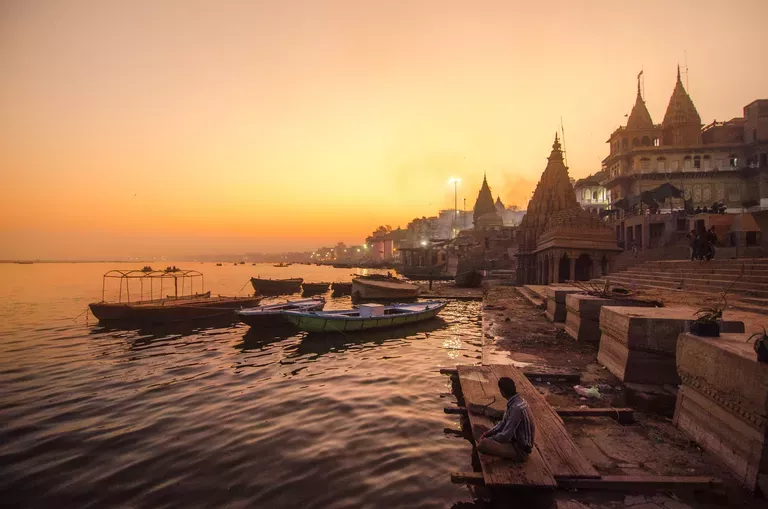

The sunrises and sunsets in Kashi are awe-inspiring. As the sun casts its golden rays on the river and the city, you’ll feel a sense of wonder and tranquility that is hard to replicate anywhere else.
7.Cultural Extravaganza:
Kashi is a hub of artistic expression. From classical music to traditional dance forms, the city hosts various cultural events and festivals throughout the year. Immerse yourself in the vibrancy and splendor of these artistic celebrations.
Varanasi, being a cultural hub of India, has a rich tradition of classical music and dance, along with various forms of folk music and dance.
Classical Music:
a) Hindustani Classical Music: Varanasi is renowned for its association with Hindustani classical music. It has been a significant center for the development and propagation of this classical music form. The city has produced many renowned classical musicians and Gharanas (musical lineages), such as the Benaras Gharana, which has contributed significantly to the growth of Indian classical music.
b) Dhrupad: Dhrupad, one of the oldest forms of classical music, is deeply cherished in Varanasi. The city has been a significant center for Dhrupad performances and training for centuries.
Classical Dance:
a) Kathak: Varanasi is closely associated with the classical dance form of Kathak. The city has nurtured numerous Kathak dancers and gurus who have contributed to preserving and promoting this ancient dance tradition.
Folk Music and Dance:
a) Lok Geet: Varanasi has a vibrant tradition of Lok Geet, which refers to the folk songs of the region. These songs are often sung in local dialects and reflect the culture, traditions, and social life of the people.
b) Kajri and Chaiti: Kajri and Chaiti are two popular forms of folk music in Varanasi. Kajri is sung during the monsoon season, while Chaiti is sung during the spring festival of Chaitra.
c) Ramlila: Ramlila, a traditional folk-theatrical performance based on the epic Ramayana, is popular in Varanasi. It is enacted during the festival of Dussehra with great enthusiasm.
d) Raslila: Raslila is a form of folk dance depicting the divine love of Radha and Krishna. It is performed during festive occasions like Holi and Janmashtami.
8.Sarnath Excursion:
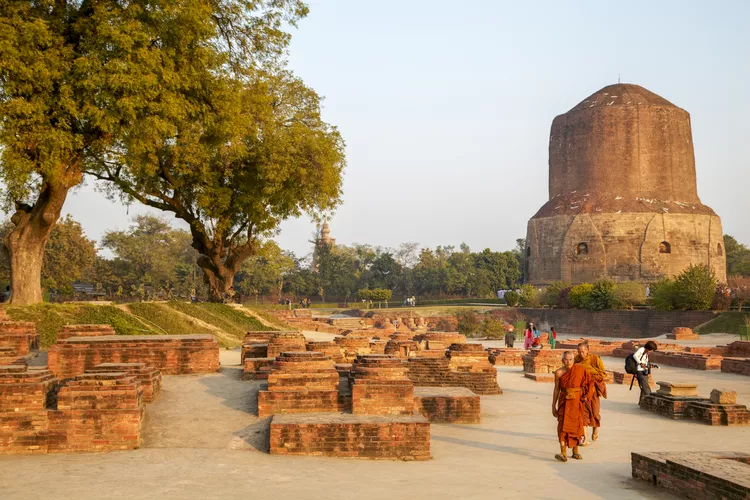

A short distance from Kashi lies Sarnath, a place where Lord Buddha delivered his first sermon. Explore the ancient ruins and soak in the spiritual atmosphere, gaining insights into the teachings of Buddhism.
Sarnath is an important religious and historical site located near Varanasi in the state of Uttar Pradesh, India.
Location of Sarnath is situated approximately 13 kilometers northeast of Varanasi city. It is easily accessible from Varanasi and serves as an essential pilgrimage destination for Buddhists and travelers alike.
Architecture of Sarnath is famous for its archaeological ruins and ancient monuments that date back to the time of Gautama Buddha. The most prominent structure is the Dhamek Stupa, a massive cylindrical tower that marks the spot where Buddha is believed to have given his first sermon after attaining enlightenment. The stupa’s architecture is a blend of Mauryan and Gupta styles, showcasing intricate carvings and elaborate designs.
Religious Value of Sarnath holds immense religious significance in Buddhism as it is one of the four major pilgrimage sites for Buddhists. It is often referred to as one of the holiest places in Buddhism. As the place where Buddha delivered his first sermon, known as “Dhammacakkappavattana Sutta,” Sarnath marks the beginning of the Buddhist sangha (community of monks).
Historical Significance of Sarnath , Apart from the Dhamek Stupa, Sarnath houses several other notable structures, including the Chaukhandi Stupa, Mulagandha Kuti Vihar, and Ashoka Pillar. The Ashoka Pillar, erected by Emperor Ashoka in the 3rd century BCE, bears inscriptions that attest to his conversion to Buddhism and the propagation of the teachings of Buddha.
Modern Temples and Monasteries of Sarnath In addition to the ancient monuments, Sarnath is home to various modern temples and monasteries built by Buddhist communities from different countries. These structures add to the spiritual ambiance of the place and attract pilgrims from various parts of the world.
Visiting Sarnath offers a unique opportunity to delve into the roots of Buddhism, experience the tranquility of the surroundings, and explore the remarkable architectural and historical heritage that holds significant importance in the world’s religious and cultural heritage.
9.Self-Reflection and Contemplation:
Kashi’s tranquil ambiance provides an ideal setting for self-reflection and contemplation. Many visitors find solace in the city’s spiritual energy, leading to a deeper understanding of themselves and their place in the universe.
What is Panchakroshi Yatra:
The Panchakroshi Yatra is a significant pilgrimage tradition in Varanasi, also known as Kashi. It involves circumambulating a route of approximately 10 miles (16 kilometers) around the sacred city.
Basic details about the Panchakroshi Yatra:
Pilgrimage Route of Panchakroshi ,The Yatra involves visiting five important places of religious significance, known as “Panchakroshi,” which are located at specific distances from the main city. These places include Kardmeshwar, Bhimchandi, Rameshwar, Shivpur, and Kapildhara.
Duration of Panchakroshi Yatra ,The pilgrimage usually takes five days to complete, with each day dedicated to visiting one of the five sacred spots.
Rituals and Importance of Panchakroshi Yatra ,During the Yatra, devotees perform various rituals, and prayers, and offer obeisance to the deities at each of the Panchakroshi locations. It is believed that undertaking this pilgrimage helps cleanse one’s sins and bestows spiritual merits.
Occurrence of The Panchakroshi Yatra is traditionally performed during specific auspicious times, such as in the month of Bhadrapada (August-September), on specific lunar days, or during significant religious festivals.
Spiritual Significance of Panchakroshi Yatra , holds great spiritual significance as it connects devotees to the sacred energy and historical roots of Varanasi. It is believed that the act of walking the Panchakroshi route helps seekers attain spiritual growth, blessings, and divine grace.
10.Rich Craftsmanship:
Kashi is known for its skilled artisans who create exquisite handicrafts. Take a stroll through the narrow lanes and witness the artistry behind silk fabrics, brassware, and other traditional crafts.
The crafts of Varanasi are diverse and encompass a wide range of artistic skills. Some of the prominent crafts of Varanasi are:
- Banarasi Silk Sarees: Banarasi silk sarees are the most famous and iconic craft of Varanasi. These sarees are known for their intricate weaving patterns, exquisite designs, and use of fine silk and gold or silver zari threads. They are highly sought after for weddings and special occasions.


- Brocade Weaving: Varanasi is known for its traditional brocade weaving, which involves creating elaborate patterns and designs on fabrics using gold or silver threads. This craft is not only used for sarees but also for clothing, home furnishings, and accessories.
- Zari Work: Zari work is the art of embellishing fabrics with metallic threads, usually made of gold or silver. This craft is extensively used in various textiles and garments in Varanasi.
- Metalwork: Varanasi is famous for its metalwork, especially in brass and copper. Skilled artisans create beautiful and intricate metalware, including religious artifacts, utensils, and home decor items.
- Wooden Toys: Varanasi is known for its traditional wooden toys, which are handcrafted by local artisans. These toys are often made in the shape of animals, deities, and mythological characters. And,
- The “Wooden Vishvarupa Darshan” at Varanasi refers to a unique and captivating art installation depicting the cosmic form of Lord Vishnu, known as Vishvarupa. This artwork showcases Lord Vishnu displaying his universal form, encompassing the entire cosmos.
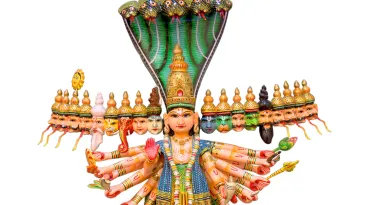

- Ivory Carving: Though the use of ivory is now restricted, Varanasi was once known for its intricate ivory carving work. The artisans would create beautiful and detailed carvings on ivory.
- Stone Carving: The city is home to skilled stone carvers who create intricate sculptures, statues, and decorative pieces from various types of stone.
- Embroidery: Varanasi is also known for its embroidery work, which involves decorating fabrics with beautiful threadwork and embellishments.
- Glass Beads and Jewelry: The city is renowned for its glass beadwork, used in jewelry and decorative items.
- Pottery: Traditional pottery is also practiced in Varanasi, where clay artisans create various items like clay pots, lamps, and decorative pieces.
11.Circle of Life and Death:
Witnessing the cremation rituals at the Manikarnika Ghat may seem intense, but it offers a profound insight into the cycle of life and death. This humbling experience prompts contemplation on the impermanence of existence.
Manikarnika Ghat:-
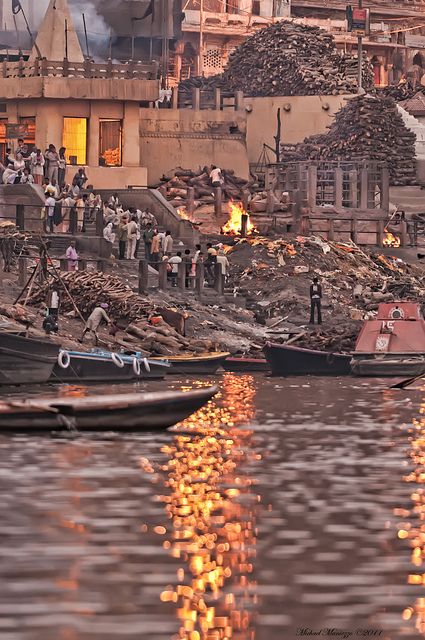

Manikarnika Ghat is one of the most important and prominent ghats in Varanasi, situated on the banks of the sacred River Ganges.
Basic details about Manikarnika Ghat:
Location of Manikarnika Ghat is located in the heart of Varanasi, along the western bank of the River Ganges.
Importance of Manikarnika Ghat ,This ghat is considered one of the holiest and most auspicious cremation grounds in Varanasi. It is believed that cremation at this ghat ensures liberation from the cycle of birth and death (moksha) and bestows blessings to the departed souls.
Sacred Legend: According to Hindu mythology, it is said that Goddess Parvati lost her earring (Manikarnika) at this spot while bathing in the Ganges. Lord Shiva, in order to help her find the earring, created a Kund (pond) known as Manikarnika Kund. The ghat derives its name from this sacred legend.
Rituals of Manikarnika Ghat, Cremations are continuously performed at Manikarnika Ghat, as it is believed that the sacred fire of Lord Shiva’s eternal flame burns here, symbolizing the cycle of life and death. The ashes of the departed are immersed in the Ganges, which is considered an act of liberation and a way to attain salvation.
Pilgrimage Destination of Manikarnika Ghat is visited by numerous pilgrims and devotees from all over the world, seeking to perform the last rites for their departed loved ones or to witness this sacred and profound aspect of Hindu funeral traditions.
Manikarnika Ghat’s significance as a place of final rites and its association with the eternal cycle of life and death make it an essential and deeply revered spot in Varanasi, adding to the city’s spiritual allure.
Conclusion:
Kashi’s allure lies not only in its spirituality but also in its cultural riches and historical significance. A visit to this sacred city is a transformative journey that leaves a lasting impression on the heart and soul. Embrace the spiritual sanctity, immerse yourself in the traditions, and witness the eternal beauty of Kashi, India’s sacred city, at least once in your lifetime.

